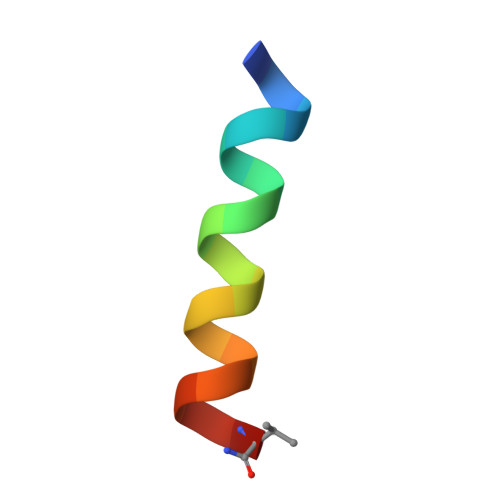Decoding the Functional Roles of Cationic Side Chains of the Major Antimicrobial Region of Human Cathelicidin LL-37.
Wang, G., Epand, R.F., Mishra, B., Lushnikova, T., Thomas, V.C., Bayles, K.W., Epand, R.M.(2012) Antimicrob Agents Chemother 56: 845-856
- PubMed: 22083479
- DOI: https://doi.org/10.1128/AAC.05637-11
- Primary Citation of Related Structures:
2L5M - PubMed Abstract:
Human cathelicidin LL-37 is a critical cationic antimicrobial peptide for host defense against infection, immune modulation, and wound healing. This article elucidates the functional roles of the cationic side chains of the major antimicrobial region of LL-37, corresponding to residues 17 to 32 (designated GF-17). Antimicrobial assays, killing kinetics studies, and vesicle leakage experiments all indicate that a conversion of lysines to arginines affected the ability of the peptide to kill the Gram-positive Staphylococcus aureus strain USA300. Alanine scanning experiments show that S. aureus is less sensitive than Escherichia coli to a single cationic residue mutation of GF-17. Among the five cationic residues, R23 appears to be somewhat important in killing S. aureus. However, R23 and K25 of GF-17 are of prime importance in killing the Gram-negative organism E. coli. In particular, R23 is essential for (i) rapid recognition, (ii) permeation of the E. coli outer membrane, (iii) clustering of anionic lipids in a membrane system mimicking the E. coli inner membrane, and (iv) membrane disruption. Bacterial aggregation (i.e., rapid recognition via charge neutralization) is the first step of the peptide action. Structurally, R23 is located in the interface (i.e., the first action layer), a situation ideal for the interactions listed above. In contrast, residues K18, R19, and R29 are on the hydrophilic surface of the amphipathic helix and play only a secondary role. Mapping of the functional spectrum of cationic residues of GF-17 provides a solid basis for engineering bacterium-specific antimicrobials using this highly potent template.
Organizational Affiliation:
Department of Pathology and Microbiology, College of Medicine, University of Nebraska Medical Center, Omaha, Nebraska, USA. gwang@unmc.edu














